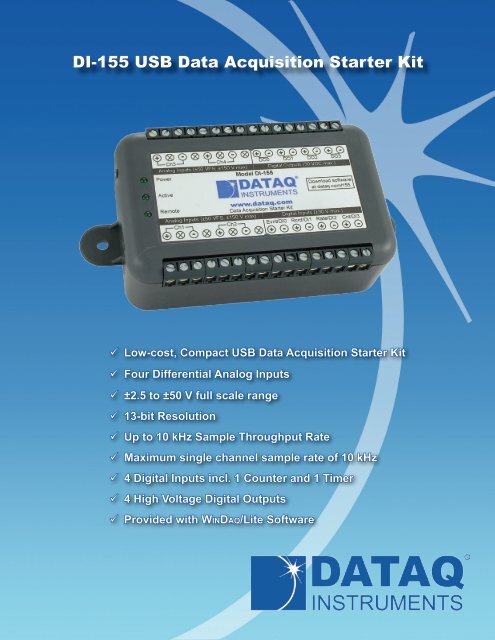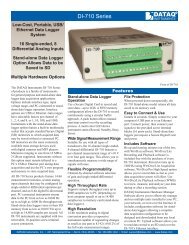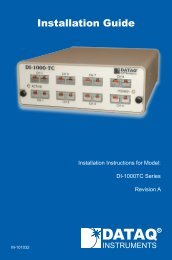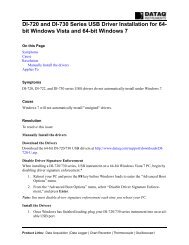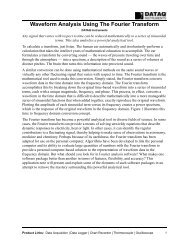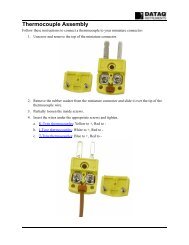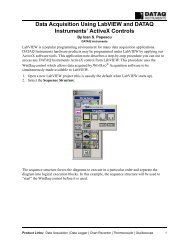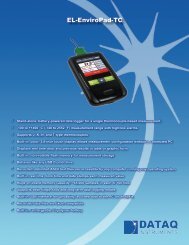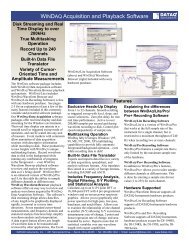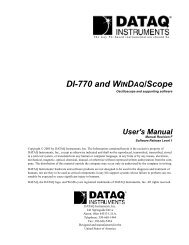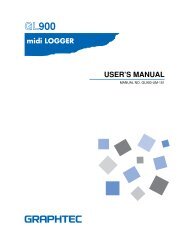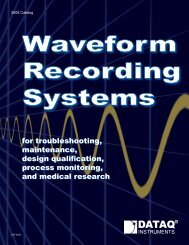DI-155 USB Data Acquisition Starter Kit - DATAQ Instruments
DI-155 USB Data Acquisition Starter Kit - DATAQ Instruments
DI-155 USB Data Acquisition Starter Kit - DATAQ Instruments
You also want an ePaper? Increase the reach of your titles
YUMPU automatically turns print PDFs into web optimized ePapers that Google loves.
<strong>DI</strong>-<strong>155</strong> <strong>USB</strong> <strong>Data</strong> <strong>Acquisition</strong> <strong>Starter</strong> <strong>Kit</strong><br />
99<br />
Low-cost, Compact <strong>USB</strong> <strong>Data</strong> <strong>Acquisition</strong> <strong>Starter</strong> <strong>Kit</strong><br />
99<br />
Four Differential Analog Inputs<br />
99<br />
±2.5 to ±50 V full scale range<br />
99<br />
13-bit Resolution<br />
99<br />
Up to 10 kHz Sample Throughput Rate<br />
99<br />
Maximum single channel sample rate of 10 kHz<br />
99<br />
4 Digital Inputs incl. 1 Counter and 1 Timer<br />
99<br />
4 High Voltage Digital Outputs<br />
99<br />
Provided with WinDaq/Lite Software
<strong>DI</strong>-<strong>155</strong> Description<br />
The new <strong>DI</strong>-<strong>155</strong> is a full-featured data acquisition system at a starter kit price that will change the way you measure price and performance.<br />
It combines analog input and digital I/O flexibility to yield a nearly indestructible solution for tough industrial measurements.<br />
Four armored differential analog inputs measure from ±2.5 to ±50 volts full scale across eight independently programmable ranges per<br />
channel. Their armored design allows them to tolerate transient over-voltages to ±150 VDC or peak AC, so the <strong>DI</strong>-<strong>155</strong> absorbs abuse and<br />
bounces back for more. And the <strong>DI</strong>-<strong>155</strong>’s 13-bit ADC operates at a maximum throughput rate of 10 kHz, so you won’t miss any signal<br />
activity that might blow past more costly but less capable instruments.<br />
Then there’s the digital I/O. Each of the <strong>DI</strong>-<strong>155</strong>’s four digital input bits will tolerate up to ±30 V without damage. Use them as four<br />
discrete inputs, or program one for a counter and another as a timer for frequency, RPM, or cycle count measurements. And each of the<br />
<strong>DI</strong>-<strong>155</strong>’s digital outputs can switch loads as great as 30 volts and can sink as much as 500 mA.<br />
The <strong>DI</strong>-<strong>155</strong> is powered directly from the connected computer’s <strong>USB</strong> port, so you don’t have to wrestle with external power supplies.<br />
And it’s provided with our powerful WinDaq/Lite software for Windows that allows a real time display of any combination of analog and<br />
digital channels, and the ability to stream acquired data to disk in recorder-like fashion. Two of the <strong>DI</strong>-<strong>155</strong>’s digital inputs may be used<br />
for remote stop/start and remote event operations using WinDaq software. WinDaq also includes software to review recorded data files,<br />
including waveform analysis and data file export to Microsoft Excel and other applications.<br />
<strong>DI</strong>-<strong>155</strong> Close-up<br />
Analog In Channels 3 and 4<br />
±2.50, 3.125, 5, 6.25, 10, 12.50, 25, 50<br />
VFS per channel max<br />
Screw terminals for signal inputs<br />
Remote Event push-button<br />
Trigger events either from the remote event inputs<br />
(through WinDaq software) or by pushing this button.<br />
= No Connection Digital Out Channels<br />
30 VDC max., 0.5 A sink current max.<br />
LED Indication<br />
Power LED indicates power is applied<br />
Active LED indicates the device is<br />
scanning input data<br />
Digital LED indicates use of a<br />
digital input<br />
Bulkhead<br />
Mounting Ears<br />
Bulkhead<br />
Mounting Ears<br />
Mini-B <strong>USB</strong> connection<br />
Analog In Channels 1 and 2<br />
±2.50, 3.125, 5, 6.25, 10, 12.50, 25, 50<br />
VFS per channel max<br />
= No Connection<br />
Digital In Channels<br />
<strong>DI</strong>0 and <strong>DI</strong>1 can be used for Remote Events and Start/Stop<br />
control using WinDaq software<br />
<strong>DI</strong>2 and <strong>DI</strong>3 can be used for Counter/Timer applications<br />
All inputs may be programmed to operate as a 4-bit digital<br />
input port.<br />
Screw terminals for signal inputs<br />
www.dataq.com 2 330-668-1444
Four Differential Analog Input Channels<br />
Measure as many as four system variables at the same time.<br />
13-bit ADC resolution<br />
Provides 610 microvolt resolution on the <strong>DI</strong>-<strong>155</strong>’s most sensitive<br />
measurement range.<br />
Ruggedized Inputs<br />
All four <strong>DI</strong>-<strong>155</strong> analog inputs and both discrete inputs are overvoltage<br />
protected. Accidents that happen are quickly forgiven.<br />
Noise-cancelling Analog Input Configuration<br />
The noise-immunity of differential inputs minimizes the affects of<br />
common mode noise so often encountered in industrial measurements.<br />
<strong>USB</strong> Interface<br />
The <strong>DI</strong>-<strong>155</strong> is provided with a built-in <strong>USB</strong> interface, allowing<br />
it to be connected and run with any laptop or desktop PC. The<br />
<strong>USB</strong> interface provides power to the <strong>DI</strong>-<strong>155</strong>, eliminating clumsy<br />
external power supplies.<br />
Wide OS support<br />
Signed drivers are provided with the <strong>DI</strong>-<strong>155</strong> that allow troublefree<br />
installation for Windows XP and both 32- and 64-bit versions<br />
of Windows Vista and Windows 7.<br />
Four High Voltage Digital Outputs<br />
Four digital outputs are provided that can handle loads up to 30<br />
VDC or peak AC and 500 mA.<br />
<strong>DI</strong>-<strong>155</strong> Major Features and Benefits<br />
Published Protocol<br />
Program the <strong>DI</strong>-<strong>155</strong> with any programming language under any<br />
operating system using our published set of commands and responses<br />
for <strong>DI</strong>-<strong>155</strong> configuration, analog input and digital I/O.<br />
Four Digital Inputs<br />
Four general-purpose discrete inputs allow remote event and stop/<br />
start operations with WinDaq software. Two of the four double as<br />
counter inputs for rate and totalize operations.<br />
Included WinDaq/Lite software<br />
Our WinDaq/Lite data acquisition software offers real time display<br />
and disk streaming for the Windows environment up to 240 Hz.<br />
The real time display can operate in a smooth scroll or triggered<br />
sweep mode of operation, and can be scaled into any unit of measure.<br />
Event markers with comments allow you to annotate your<br />
data acquisition session with descriptive information as you’re<br />
recording to disk. Raise your productivity to new heights with<br />
WinDaq’s unique multitasking feature. Record waveform data to<br />
disk in the background while running any combination of programs<br />
in the foreground — even WinDaq Playback software to review<br />
and analyze the waveform data as it’s being stored! Playback supports<br />
waveform analysis (Statistics, X-Y plots, frequency analysis)<br />
and the ability to export data to Microsoft Excel. WinDaq/<br />
Lite recording and playback software is provided free with every<br />
<strong>DI</strong>-<strong>155</strong> purchase. See the WinDaq Multimedia Tutorial for more<br />
information. Optional WinDaq/HS-<strong>155</strong> unlocks the 240 Hz real<br />
time recording restriction to allow sample rates to the full 10 kHz<br />
capability of the hardware.<br />
<strong>DI</strong>-<strong>155</strong> Dimensional Drawing<br />
1.612"<br />
Ø 0.200"<br />
(2 places)<br />
0.750"<br />
2.625"<br />
4.250"<br />
4.750"<br />
5.500"<br />
330-668-1444 3 www.dataq.com
<strong>DI</strong>-<strong>155</strong> Block Diagram<br />
<strong>DI</strong>N0<br />
(Remote Events)<br />
+V<br />
47K<br />
47K<br />
Digital Outputs<br />
Typical 4 places<br />
Absolute Maximum Ratings<br />
V DO0<br />
to Common: 30 V<br />
I Load<br />
(sink): 0.5 A<br />
I Load<br />
(source): 0.3 mA<br />
10K<br />
VBus<br />
DOUT0<br />
Load<br />
*<br />
<strong>DI</strong>N1<br />
4.7K<br />
Digital In<br />
Typical 4 places<br />
VBias (½Vref)<br />
Digital In 1<br />
(Remote Start/Stop)<br />
EEPROM<br />
(Calibration,<br />
Model #,<br />
Serial #)<br />
4.7K<br />
10<br />
+V<br />
Common<br />
I Load<br />
*Required for Inductive<br />
Loads such as a relay<br />
<strong>DI</strong>N2<br />
<strong>DI</strong>N3<br />
Digital In 2<br />
(Rate)<br />
Digital In 3<br />
(Counts)<br />
General Purpose I/O<br />
VBus<br />
Event<br />
Remote<br />
1500pF<br />
20K<br />
AVR32 CPU<br />
VRef = 3.33V<br />
Active<br />
Power<br />
AIN1<br />
No<br />
Connection<br />
1M<br />
10<br />
0.1μF<br />
½Vref<br />
20K<br />
1500pF<br />
20K<br />
C/T 1 C/T 0<br />
ADC<br />
<strong>USB</strong><br />
VReg<br />
VBus<br />
<strong>USB</strong><br />
10<br />
ATMEL<br />
Microcontroller<br />
SPI<br />
Panel<br />
1M<br />
0.1μF<br />
20K<br />
½Vref<br />
Control<br />
Analog In<br />
Typical 4<br />
places<br />
Mux<br />
PGA<br />
ADC<br />
Analog In 4<br />
Panel<br />
www.dataq.com 4 330-668-1444
Setup<br />
Included WinDaq/Lite Recording Software (click on graphics for close-up views)<br />
Double-click and enter the channels you want to acquire into the<br />
WinDaq scan list. Click to select signal averaging, true RMS,<br />
frequency, and peak or valley detection per channel. Click to<br />
define a single to 4-channel display — either triggered sweep<br />
(oscilloscope-like) or scrolling (chart recorder-like). Click again<br />
to define a sample rate from 1.26 samples per hour to 240 samples<br />
per second (10,000 Hz with High Speed option).<br />
Calibrate<br />
Define calibration per channel to display waveform values in<br />
meaningful units such as psi, °F or °C, amps, rpm, watts, horsepower<br />
— any unit of measure you need.<br />
Record<br />
Choose a continuous waveform recording mode or the triggered<br />
mode with selectable trigger level, slope, and post-trigger times.<br />
WinDaq automatically time- and date-stamps, then streams<br />
acquired data to disk — record as much data as you need. At the<br />
same time, WinDaq supplies a real-time graphical display of any<br />
or all channels so you always know where you are and where<br />
you’re going.<br />
Annotate<br />
Of course, you can label any channel with text that describes<br />
it — “Motor 1,” “Engine speed,” “Vertical position,” etc. But<br />
WinDaq also allows you to supply commented event markers<br />
while you record — “Beginning test phase 1,” “Small vibrations<br />
noticed,” “Starting cool-down cycle,” etc. Your comments and<br />
our acquired data combine to form a complete diary of your data<br />
acquisition session.<br />
330-668-1444 5 www.dataq.com
Playback<br />
Recording is only half the solution. WinDaq’s Waveform Browser<br />
playback software allows you to graphically manipulate waveforms<br />
in ways you’ve never seen on a PC. Compress an entire<br />
recording to one screen-width for a bird’s eye view, then expand<br />
around an area of interest for a closer look. Use the cursor to<br />
measure amplitudes and timing with precision. Move to any event<br />
marker with the click of a mouse button.<br />
Included WinDaq Playback Software<br />
Multitask<br />
Double your productivity and let WinDaq record while you review<br />
last week’s results from your spreadsheet, or compose a memo<br />
with your word processor. You can even play back data already<br />
stored to disk while you’re still recording.<br />
Analyze<br />
Waveform interpretation is easy with our built-in analysis functions.<br />
Apply frequency and filtering analysis with the WinDaq<br />
Waveform Browser FFT and DFT functions. Analyze any range<br />
of waveform data with the statistics function. Use X-Y plotting to<br />
examine the relationship of one channel to another. Optional Advanced<br />
CODAS analysis functions allow waveform peak detection,<br />
integration, differentiation, arithmetic operations, and more.<br />
Export<br />
The WinDaq Waveform Browser can export any range of data<br />
to your spreadsheet, or any other analysis or presentation package<br />
you use. You can even copy a graphical image displayed by<br />
the WinDaq Waveform Browser and paste it directly into a word<br />
processing document. Finally, export any range of waveform<br />
graphics to your printer for a hard copy record.<br />
www.dataq.com 6 330-668-1444
WinDaq/HS Upgrade<br />
A WinDaq High Speed upgrade gives you all the features and capability of WinDaq/Lite software, but without the 240 Hz sample<br />
rate limitation. With WinDaq/HS you can sample at the maximum 2.5 kHz per channel capability of <strong>DI</strong>-<strong>155</strong> the hardware, up to a<br />
maximum throughput rate of 10 kHz for four enabled channels.<br />
Published and Supported Instrument Protocol<br />
We know that there are some applications for the <strong>DI</strong>-<strong>155</strong> that only you can program, from single unit special-purpose applications,<br />
to OEM requirements by the hundreds of units. We further realized that Windows might not be the best development environment<br />
in these situations, and the range of programming environment preferences runs wide and deep. For all these reasons <strong>DATAQ</strong><br />
<strong>Instruments</strong> has decided to publish and maintain a document that defines the <strong>DI</strong>-<strong>155</strong> protocol, the command set that defines how<br />
to communicate with the <strong>DI</strong>-<strong>155</strong> at the instrument level. With this information at your disposal you are not bound to any particular<br />
operating system or programming language, so how you use the <strong>DI</strong>-<strong>155</strong> is limited only by instrument’s hardware and your own<br />
imagination.<br />
330-668-1444 7 www.dataq.com
Typical <strong>DI</strong>-<strong>155</strong> Applications<br />
Replace Traditional Chart Recorders<br />
Replace traditional chart recorders by digitizing and recording the measurements of specialized instruments with high-level monitor<br />
outputs:<br />
Equipment<br />
Model <strong>DI</strong>-<strong>155</strong><br />
PC<br />
-<br />
Analog Out<br />
±2.5 to ±50 VFS<br />
programmable<br />
per channel<br />
+<br />
+ - + - + - + - + - + -<br />
Ch3<br />
Ch4<br />
DO0 DO1 DO2 DO3<br />
Analog Inputs (±50 VFS, ±150 V max) Digital Outputs (30 VDC max.)<br />
Power<br />
Model <strong>DI</strong>-<strong>155</strong><br />
Download software<br />
Active<br />
at dataq.com/<strong>155</strong><br />
www.dataq.com<br />
= No Connection<br />
Remote<br />
<strong>Data</strong> <strong>Acquisition</strong> <strong>Starter</strong> <strong>Kit</strong><br />
Analog Inputs (±50 VFS, ±150 V max) Digital Inputs (±30 V max.)<br />
Ch1<br />
Ch2<br />
Evnt/<strong>DI</strong>0 Rcrd/<strong>DI</strong>1 Rate/<strong>DI</strong>2 Cnt/<strong>DI</strong>3<br />
+ - + - + - + - + - + -<br />
<strong>USB</strong> Cable<br />
(3 more analog input channels as needed)<br />
Any Windows-compatible computer<br />
see specifications for supported<br />
Operating Systems<br />
Examples of “Equipment” above include gas chromatographs, liquid chromatographs, spectrometers, bio-amplifiers*, etc.<br />
* <strong>DATAQ</strong> <strong>Instruments</strong>’ hardware and software products are NOT designed to be used in the diagnosis and treatment of humans, nor are they to be used as critical components in any lifesupport<br />
systems whose failure to perform can reasonably be expected to cause significant injury to humans.<br />
Amplified Transducer Monitor<br />
Connecting directly to the output of amplified voltage- or current-mode transducers:<br />
Model <strong>DI</strong>-<strong>155</strong><br />
Power<br />
+ + +<br />
- -<br />
R250*<br />
-<br />
Transducer/Sensor**<br />
Ch1 Ch2<br />
+ - + -<br />
Evnt/<strong>DI</strong>0 Rcrd/<strong>DI</strong>1 Rate/<strong>DI</strong>2 Cnt/<strong>DI</strong>3<br />
+ - + - + - + -<br />
www.dataq.com<br />
= No Connection<br />
Remote<br />
<strong>Data</strong> <strong>Acquisition</strong> <strong>Starter</strong> <strong>Kit</strong><br />
Analog Inputs (±50 VFS, ±150 V max) Digital Inputs (±30 V max.)<br />
Active<br />
Download software<br />
at dataq.com/<strong>155</strong><br />
+ - + - + - + - + - + -<br />
Ch3<br />
Ch4<br />
DO0 DO1 DO2 DO3<br />
Analog Inputs (±50 VFS, ±150 V max) Digital Outputs (30 VDC max.)<br />
Power<br />
Model <strong>DI</strong>-<strong>155</strong><br />
PC<br />
<strong>USB</strong> Cable<br />
*Model R250 resistor required for 4-20mA outputs<br />
**Typical Transducer/Sensor above includes pressure, load, torque, etc.<br />
Any Windows-compatible computer<br />
see specifications for supported<br />
Operating Systems<br />
Typical Transducer/Sensors above include pressure, load, torque, Etc.<br />
www.dataq.com 8 330-668-1444
-<br />
Typical <strong>DI</strong>-<strong>155</strong> Applications (continued)<br />
Process Monitoring<br />
Trend plot and record control and feedback signals to troubleshoot process glitches.<br />
Control and Feedback Signals<br />
(±V, 4-20mA*)<br />
PLC<br />
Process<br />
+ - + - + - + - + - + -<br />
Ch3<br />
Ch4<br />
DO1<br />
DO0 DO2 DO3<br />
Analog Inputs (±50 VFS, ±150 V max) Digital Outputs (30 VDC max.)<br />
Model <strong>DI</strong>-<strong>155</strong><br />
Power<br />
PC<br />
Active<br />
Download software<br />
at dataq.com/<strong>155</strong><br />
www.dataq.com<br />
= No Connection<br />
Remote<br />
<strong>Data</strong> <strong>Acquisition</strong> <strong>Starter</strong> <strong>Kit</strong><br />
Analog Inputs (±50 VFS, ±150 V max) Digital Inputs (±30 V max.)<br />
Ch1<br />
Ch2<br />
Evnt/<strong>DI</strong>0 Rcrd/<strong>DI</strong>1 Rate/<strong>DI</strong>2 Cnt/<strong>DI</strong>3<br />
+ - + - + - + - + - + -<br />
<strong>USB</strong> Cable<br />
*Model R250 resistor required for 4-20mA outputs<br />
Model <strong>DI</strong>-<strong>155</strong><br />
Any Windows-compatible computer<br />
see specifications for supported<br />
Operating Systems<br />
Remote Control Close Up<br />
The <strong>DI</strong>-<strong>155</strong> supports several methods to increase measurement flexibility and data record interpretation. The remote record feature<br />
allows you to synchronize WinDaq recordings to external processes by remotely enabling and disabling WinDaq’s stream-to-disk<br />
feature. Remote events allow you to insert an event marker in the data stream (see inset) to identify when an event occurred relative to<br />
recorded waveform activity. Events can be activated by the pushbutton on the <strong>DI</strong>-<strong>155</strong> enclosure, through a keyboard keystroke (which<br />
also allows you to record a description), or remotely via the remote event input. The stream-to-disk function can also be controlled<br />
through the keyboard, or through the remote record input. Valid remote record and event signals are switch closures, or discrete levels<br />
with a maximum input of 30 V and a threshold of 1.8 V.<br />
Event Marker<br />
30V Max<br />
0V<br />
TTL<br />
Manually push button to insert an<br />
Event Marker in the <strong>Data</strong> Stream<br />
1.8V Threshold<br />
Switch Closure<br />
TTL or<br />
Switch<br />
Closure<br />
+<br />
Ch3<br />
Analog Inputs (±50 VFS, ±150 V max)<br />
Power<br />
Model <strong>DI</strong>-<strong>155</strong><br />
www.dataq.com<br />
<strong>Data</strong> <strong>Acquisition</strong> <strong>Starter</strong> <strong>Kit</strong><br />
Analog Inputs (±50 VFS, ±150 V max) Digital Inputs (±30 V max.)<br />
Ch2<br />
Evnt/<strong>DI</strong>0 Rcrd/<strong>DI</strong>1 Rate/<strong>DI</strong>2<br />
+ - + - + -<br />
330-668-1444 9 www.dataq.com
Rate Measurements<br />
The <strong>DI</strong>-<strong>155</strong>’s Rate input is used to acquire a frequency<br />
representing RPM, flow, or any other pulse stream.<br />
Typical <strong>DI</strong>-<strong>155</strong> Applications (continued)<br />
www.dataq.com<br />
<strong>Data</strong> <strong>Acquisition</strong> <strong>Starter</strong> <strong>Kit</strong><br />
Digital Inputs (±30 V max.)<br />
Evnt/<strong>DI</strong>0 Rcrd/<strong>DI</strong>1 Rate/<strong>DI</strong>2 Cnt/<strong>DI</strong>3<br />
+ - + - + -<br />
Count Measurements<br />
Use the <strong>DI</strong>-<strong>155</strong>’s Count input to accumulate a tally of applied<br />
discrete pulses to track test cycles, extract volume from flow, or<br />
any other general-purpose totalizing application.<br />
+<br />
-<br />
+<br />
-<br />
www.dataq.com<br />
<strong>Data</strong> <strong>Acquisition</strong> <strong>Starter</strong> <strong>Kit</strong><br />
Digital Inputs (±30 V max.)<br />
Rcrd/<strong>DI</strong>1 Rate/<strong>DI</strong>2 Cnt/<strong>DI</strong>3<br />
+ - + - + -<br />
Evnt/<strong>DI</strong>0<br />
Digital Outputs<br />
The <strong>DI</strong>-<strong>155</strong>’s digital outputs are not your ordinary transistor switches. Each of four channels features a dedicated MOSFET that can<br />
handle high voltage and current loads with built-in electrostatic discharge protection. It can switch loads of up to 30 Volts (DC or peak<br />
AC) and 500 mA with an on resistance of less than 2 Ohms. Use it to control relays where the load to be switched exceeds the 30 V,<br />
500 mA spec of the port, or to control the load directly where it does not. Software access to the digital output ports can be through the<br />
<strong>DI</strong>-<strong>155</strong> protocol, or via WinDaq software using a third party software add-on.<br />
To control<br />
logic<br />
4.7K<br />
10K<br />
+3.3V<br />
10<br />
Digital Outputs (30 VDC max.)<br />
+ -<br />
DO1 DO2 DO3<br />
+ - + -<br />
*<br />
Load<br />
500mA<br />
Max<br />
+<br />
30 VDC<br />
V<br />
or peak AC<br />
-<br />
*Clamping diode required<br />
for inductive loads<br />
www.dataq.com 10 330-668-1444
Signal Inputs<br />
Analog Inputs<br />
Number of Channels: 4<br />
Configuration: Differential<br />
Programmable measurement ranges per<br />
channel:<br />
Input impedance:<br />
Isolation:<br />
Absolute Accuracy (@ 25°C, excluding<br />
common mode error):<br />
Absolute maximum input without<br />
damage:<br />
Maximum common mode voltage:<br />
Minimum common mode rejection:<br />
Channel-to-channel crosstalk rejection:<br />
Digital Inputs<br />
Number of Channels:<br />
Pull-up value:<br />
Isolation:<br />
Input high voltage threshold:<br />
Input low voltage threshold:<br />
Absolute maximum values:<br />
Reserved Inputs (Digital Inputs)<br />
Digital In 0:<br />
Digital In 1:<br />
ADC Characteristics<br />
Resolution:<br />
Max sample throughput rate:<br />
Max sample rate for a single channel:<br />
Min sample throughput rate:<br />
Sample rate timing accuracy:<br />
Digital Outputs<br />
±2.50, 3.125, 5, 6.25, 10, 12.50, 25,<br />
50 VFS<br />
2 MΩ, differential<br />
none<br />
± 10 V FS range: 0.20% of FS<br />
All other ranges: 0.50% of FS<br />
±75 V peak continuous<br />
±150 V peak, one minute or less<br />
±20 V peak<br />
40 db @ DC<br />
72 db minimum @ any throughput<br />
4 (2 shared with counter/timer inputs)<br />
47 KΩ<br />
none<br />
1.8 V minimum<br />
1.4 V maximum<br />
±30 VDC<br />
WinDaq remote start/stop<br />
WinDaq remote events<br />
Overall approx. 1 part in 8,192 (13-bit)<br />
Above zero: approx. 1 part in 4,095<br />
Below zero: approx. 1 part in 4,096<br />
10 kHz<br />
10 kHz<br />
Hardware only: 11.44 Hz<br />
with WinDaq Software: 0.000350 Hz<br />
50 ppm<br />
Number of Channels: 4<br />
Isolation: none<br />
Absolute max ratings: Voltage: 30 VDC or peak AC<br />
Sink current: 0.5 A<br />
Source current: 3 mA<br />
On resistance < 2 Ω<br />
<strong>DI</strong>-<strong>155</strong> Specifications<br />
Ordering Guide<br />
Counter/Rate (<strong>DI</strong>2 and <strong>DI</strong>3)<br />
Number of Channels: 2 (shared with digital inputs)<br />
Port Assignment: Rate = <strong>DI</strong>2; Counter = <strong>DI</strong>3<br />
Pull-up value: 47 KΩ<br />
Isolation: none<br />
Input high voltage threshold: 1.8 V minimum<br />
Input low voltage threshold: 1.4 V maximum<br />
Absolute maximum values: ±30 VDC<br />
Terminal count: 16,384 (14-bit)<br />
Maximum Rate Frequency: The lesser of 10 kHz or 2 × total burst rate<br />
Minimum Rate Frequency: 0.75 Hz<br />
Maximum Count Frequency: The lesser of 5 kHz or 0.50 × total burst rate<br />
(assumes 50% duty cycle square wave)<br />
Rate averaging: none<br />
Indicators and Connections<br />
Interface: <strong>USB</strong> 2.0 (mini-B style connector)<br />
Indicators (LED): Power, Active, Remote<br />
Input Connections: Two 16-position terminal strips<br />
Power<br />
Power Consumption:<br />
Environmental<br />
Operating Temperature:<br />
Operating Humidity:<br />
Storage Temperature:<br />
Storage Humidity:<br />
< 1 watt, via <strong>USB</strong> interface<br />
0°C to 35°C (32°F to 95°F)<br />
0 to 90% non-condensing<br />
-20°C to 45°C (-4°F to 113°F)<br />
0 to 90% non-condensing<br />
Physical Characteristics<br />
Enclosure: Hardened Plastic<br />
Mounting: Desktop; bulkhead<br />
Dimensions:<br />
Weight:<br />
Software Support<br />
WinDaq/Lite software (free):<br />
WinDaq/HS software<br />
(optional):<br />
Programming:<br />
2.625D × 5.5W × 1.53H in.<br />
(6.67D × 13.97W × 3.89H cm.)<br />
< 4 oz. (< 140 grams)<br />
Description<br />
<strong>DI</strong>-<strong>155</strong> <strong>Data</strong> <strong>Acquisition</strong> <strong>Starter</strong> <strong>Kit</strong><br />
<strong>Data</strong> acquisition device with <strong>USB</strong> cable, screwdriver, and free WinDaq/Lite software via Internet download (www.dataq.<br />
com/<strong>155</strong>).<br />
OS support: Windows XP (32-bit), Windows<br />
Vista and Windows 7 (32- and 64-bit versions)<br />
Sample Rate Limit: 240 Hz<br />
OS support: Same as WinDaq/Lite<br />
Sample Rate Limit: 10,000 Hz<br />
<strong>DATAQ</strong> <strong>Instruments</strong> SDK, Instrument protocol,<br />
DLL, and ActiveX Control<br />
Order No.<br />
<strong>DI</strong>-<strong>155</strong><br />
R250<br />
Optional precision 250-ohm 4-20 mA shunt resistor (see non-isolated implementation here).<br />
R250<br />
<strong>Data</strong> <strong>Acquisition</strong> Product Links<br />
(click on text to jump to page)<br />
<strong>Data</strong> <strong>Acquisition</strong> | <strong>Data</strong> Logger | Chart Recorder<br />
241 Springside Drive<br />
Akron, Ohio 44333<br />
Phone: 330-668-1444<br />
Fax: 330-666-5434<br />
<strong>DATAQ</strong>, the <strong>DATAQ</strong> logo and WinDaq are registered trademarks of <strong>DATAQ</strong> <strong>Instruments</strong>, Inc. All rights reserves. Copyright © 2012 <strong>DATAQ</strong> <strong>Instruments</strong>, Inc.<br />
The information on this data sheet is subject to change without notice.


